

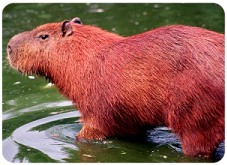 Rain forests are the most diverse ecosystems on Earth because of the incredible
numbers of animal species present. Despite the small land area they cover, rainforests are home to about half of the 5 to 10 million plant and animal
species on the globe. Most of this animal diversity is made up of insects, but many other invertebrate groups are also involved. A large rain forest
region, such as the Amazon basin, may have in excess of ten million animal species, though most of these have yet to be scientifically recorded.
Rain forests are the most diverse ecosystems on Earth because of the incredible
numbers of animal species present. Despite the small land area they cover, rainforests are home to about half of the 5 to 10 million plant and animal
species on the globe. Most of this animal diversity is made up of insects, but many other invertebrate groups are also involved. A large rain forest
region, such as the Amazon basin, may have in excess of ten million animal species, though most of these have yet to be scientifically recorded.
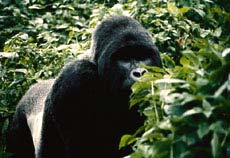 Scientists believe that there is a great diversity of animals because rainforests are the oldest ecosystems on earth. Some rainforests in Southeast
Asia have been around for at least 100 million years, when dinosaurs roamed the earth. During the Ice Ages, the last of which ended about 10,000 years
ago, the frozen areas of the North and South Poles spread over much of the earth, causing a high rate of animal extinction. But the giant freeze did not
reach a number of refuges in tropical rainforests. Therefore, rainforest plants and animals continued to evolve, developing into the most diverse and
complex ecosystems on earth.
Scientists believe that there is a great diversity of animals because rainforests are the oldest ecosystems on earth. Some rainforests in Southeast
Asia have been around for at least 100 million years, when dinosaurs roamed the earth. During the Ice Ages, the last of which ended about 10,000 years
ago, the frozen areas of the North and South Poles spread over much of the earth, causing a high rate of animal extinction. But the giant freeze did not
reach a number of refuges in tropical rainforests. Therefore, rainforest plants and animals continued to evolve, developing into the most diverse and
complex ecosystems on earth.
The nearly perfect conditions for life also helped contribute to the great number of species. With temperatures constant at 75-80¢XF year-round, animals don't have to worry about freezing during cold winters or finding shade in the hot summers. They rarely have to search for water, as rain falls almost every day in tropical rainforests. Some rainforest species have populations that number in the millions. Other species consist of only a few dozen individuals. Living in limited areas, most of these species are endemic, or found nowhere else on earth. The Maues marmoset, a species of monkey, wasn't discovered until recently. Its entire population lives within a few square miles in the Amazon rainforest. It's so small, it could sit in a person's hand!
In contrast to temperate latitude forests, animal diversity in rain forests is heavily arboreal and always greater than that found living on the ground. These conditions mostly benefit the insects which can grow and reproduce the year round, unlike the annual cycle in colder climates. Some insects grow very large. "Walking sticks" reach lengths of over 300mm. Beetles can be as large as your hand and some moths are the size of small birds. But the really amazing thing about them is their variety. One tree in the Amazon can house 200 different types of insects; not 200 insects but 200 different types! Scientists believe many insect types have yet to be named and catalogued.
 Tropical birds are also very numerous. Over 500 species are found in one small reserve in Costa Rica which is almost as many as the entire number of bird
species found in the United Kingdom. The Toucan is one of the best known tropical birds with its huge and colourful beak for picking and eating fruit.
Other fruit eaters are parrots, macaws, lorikeets and hornbills. These birds are all large, colourful and noisy, and the rainforest echoes with their calls.
Less obvious, but also very colourful are the small hummingbirds that buzz like bees through the forest gathering nectar.
Tropical birds are also very numerous. Over 500 species are found in one small reserve in Costa Rica which is almost as many as the entire number of bird
species found in the United Kingdom. The Toucan is one of the best known tropical birds with its huge and colourful beak for picking and eating fruit.
Other fruit eaters are parrots, macaws, lorikeets and hornbills. These birds are all large, colourful and noisy, and the rainforest echoes with their calls.
Less obvious, but also very colourful are the small hummingbirds that buzz like bees through the forest gathering nectar.
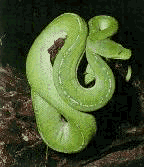 Many reptiles and amphibians also live in the forest. The most spectacular is the anaconda which can measure 9 metres. Others include the colourful, but
deadly poisonous coral snake, the python and the carpet snake (a delicacy according to the natives who eat it). The amphibians are best represented by the
frogs many of which are brightly coloured, a warning that they are poisonous to eat. They are very vocal, and their songs permeate the forest. An unusual
amphibian of the tropics is the blind salamander that has no legs and lives under logs and moss like a giant worm.
Many reptiles and amphibians also live in the forest. The most spectacular is the anaconda which can measure 9 metres. Others include the colourful, but
deadly poisonous coral snake, the python and the carpet snake (a delicacy according to the natives who eat it). The amphibians are best represented by the
frogs many of which are brightly coloured, a warning that they are poisonous to eat. They are very vocal, and their songs permeate the forest. An unusual
amphibian of the tropics is the blind salamander that has no legs and lives under logs and moss like a giant worm.
Many mammals thrive in the rainforest and bats are among the most common. However unlike their northern cousins (who eat insects) they feed mostly on fruit and nectar, although some prey on frogs. Rodents are almost as numerous as bats. The capybaras is found near rivers and is the largest rodent in the world. It is almost as big as the pony-sized tapir. Another resident of the rainforest has a long snout-like nose. Both these animals are the natural prey of the jaguar the largest South American cat. Other rainforest cats include ocelot, margay and the largest of them all, the tiger.
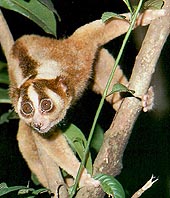 The rainforest is home to monkeys and apes. Long tailed monkeys like the howler and spider live in Central and South America. They stay in the forest
canopy and eat fruit and leaves. The howler has a very loud call that can be heard for miles. Gorillas and chimpanzees are apes which are only found in
Africa. The gorilla stays on the forest floor and its favourite food is fresh bamboo, whereas the chimpanzee is equally at home on the forest floor or in
the canopy. It will eat just about anything, fruit, leaves, insects and small animals. The other great ape is the orang-utan which only lives on the Asian
islands of Sumatra and Borneo and has an exclusive fruit diet. In contrast to gorillas and chimpanzees, which are gregarious, the orang-utan is a solitary beast.
The rainforest is home to monkeys and apes. Long tailed monkeys like the howler and spider live in Central and South America. They stay in the forest
canopy and eat fruit and leaves. The howler has a very loud call that can be heard for miles. Gorillas and chimpanzees are apes which are only found in
Africa. The gorilla stays on the forest floor and its favourite food is fresh bamboo, whereas the chimpanzee is equally at home on the forest floor or in
the canopy. It will eat just about anything, fruit, leaves, insects and small animals. The other great ape is the orang-utan which only lives on the Asian
islands of Sumatra and Borneo and has an exclusive fruit diet. In contrast to gorillas and chimpanzees, which are gregarious, the orang-utan is a solitary beast.
Life based in tropical trees has led to the evolution of several peculiar adaptations. In New World rain forests various mammal groups, such as many of the monkeys and some of the porcupines, have prehensile tails; this feature aids in mobility but also allows them to hang down to reach food that might otherwise be inaccessible. Some Asian rain forests are especially known for animals with the ability to glide. Borneo alone has over 30 species of mammals, reptiles, and amphibians that can glide from one tree to another, which is a very efficient way of getting around in a rain forest. Mutual interactions between plants and animals are characteristic of rain forests. Many animal groups, but especially insects and birds, pollinate rain forest trees, as wind is not an effective pollinator for most plant species in this relatively closed environment. The insects receive food from nectar and other substances, and in return pollinate the next flowers they visit.
After fruit is formed, rain forest plants more often than not use animals to disperse their seeds. Birds and mammals are important dispersal agents in nearly all rain forests; on Amazonian floodplains fish also play a crucial role in seed dispersal. Some animal groups provide protection to a plant species and receive living quarters in return. Ants are the most common and abundant animals found in rain forests, and they have evolved to occupy all strata, from the understory to the emergents. Many tropical plants have hollow structures in their stems or twigs that stinging or biting ants use as homes. Ants supply nutrients to the trees and also in many cases protect them from leaf and seed predators.
It is important to understand that the rainforest animals play a vital role in maintaining their habitat. Because there is no wind in the lower layers to carry pollen from one flower to another, many plants depend on insects for pollination. The 900 varieties of fig tree is a good example of this process as there are 900 different kinds of wasps that pollinate them. Spreading plant seeds is necessary for their survival, and fruit eating birds, mammals and even fish help to accomplish this task.
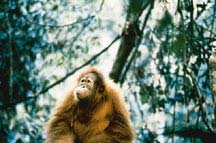 The constant search for food, water, sunlight and space is a 24-hour pushing and shoving match. With this fierce competition, you may be amazed that
so many different species of animals can all live together. But this is actually the cause of the huge number of different species. The main secret lies in
the ability of many animals to adapt to eating a specific plant or animal, which few other species are able to eat. Have you ever wondered, for instance,
why toucans and parrots have such big beaks? These beaks give them a great advantage over other birds with smaller beaks. The fruits and nuts from many
trees have evolved with tough shells to protect them from predators. In turn toucans and parrots developed large strong beaks, which serves as a
nutcracker and provides them with many tasty meals.
The constant search for food, water, sunlight and space is a 24-hour pushing and shoving match. With this fierce competition, you may be amazed that
so many different species of animals can all live together. But this is actually the cause of the huge number of different species. The main secret lies in
the ability of many animals to adapt to eating a specific plant or animal, which few other species are able to eat. Have you ever wondered, for instance,
why toucans and parrots have such big beaks? These beaks give them a great advantage over other birds with smaller beaks. The fruits and nuts from many
trees have evolved with tough shells to protect them from predators. In turn toucans and parrots developed large strong beaks, which serves as a
nutcracker and provides them with many tasty meals.